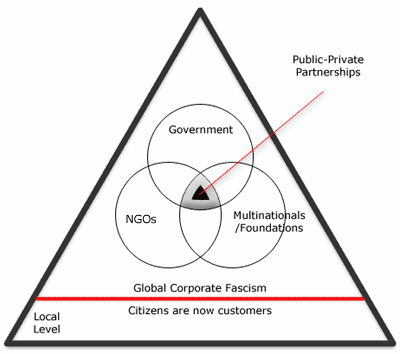A successful American corporation relies on mutually beneficial relationships between multiple parties with a vested interest in the success of the corporation. These parties’ interests lie in three domains, capital, profit, and the public. A board of directors and one or more managers of the company perceive a right to manipulate the invested capital of a corporation in the pursuit of profit. Any profit gained from this manipulation is perceived by shareholders and creditors to be their rightful property. The power of the capital manipulators relies on the desire of shareholders and creditors to realize a profit on their investment, and a belief that the manager(s) and board of directors will perform better than the shareholders in obtaining a profit. Meanwhile, the state is interested in ensuring these two parties do not collude to profit by taking advantage of and causing detriment to the public at large.
Any profit gained from this manipulation is perceived by shareholders and creditors to be their rightful property. The power of the capital manipulators relies on the desire of shareholders and creditors to realize a profit on their investment, and a belief that the manager(s) and board of directors will perform better than the shareholders in obtaining a profit. Meanwhile, the state is interested in ensuring these two parties do not collude to profit by taking advantage of and causing detriment to the public at large.
These three interests also relate to the three goals of the corporation:
- Acquire Capital
- Provide a Beneficial Product to the People
- Recoup Costs and Build Profit
Management forms a company and realizes it needs a certain amount of capital to execute their business plan but either do not possess enough capital or do not want to risk it. Thus, the management pursues capital by selling ownership in the company and rights to its profits in exchange for upfront cash. Management then desires to use this capital to purchase assets in the form of land, equipment, labor, supplies, and any other resources necessary to produce the company’s products or services.
After acquiring capital, management is able to focus on utilizing it’s resources to bringing a desirable product to the market. We, the people, appreciate the efforts of the company to produce a good or service that makes our lives better and in turn provide the company with money in exchange for their good or service. We, the people, through our representatives, ensure the company is acting ethically and delivering this product in a non-discriminatory manner, available to any consumer with the necessary cash.
Once production leads to distribution, the company can begin to recover the costs it endured in getting to and during production. During this time, shareholders and creditors keep a close eye on the recovery process, as their interests kick in the moment costs are recovered. Once profitable, shareholders and creditors perceive a right to any revenue over costs.
At the third goal, management and the shareholders begin to differ in viewpoint immensely. While management wants to funnel profits back into the company to increase it’s production ability, and in turn management’s power (if profit also increases, remember management power is derived from the shareholders’ belief that management will deliver profits). Meanwhile, shareholders grow anxious to recoup their capital investment in the form of dividends, as they begin to consider that management will have an increasingly difficult time continuing their successful streak. If management gives into shareholder’s desires and distributes profits, they will be less capable of increasing production, and thus less capable of driving costs down, and thus less capable of delivering their socially beneficial product to more people.
Here, the State grows curious why the company is performing so well, yet charging the same price and not servicing a greater portion of the community. The representatives of the people then urge the company to lower prices or increase supply, in order to deliver this product to more people, or at least provide it at a lower cost.  Fearing the wrath of the State in higher corporate taxes, which would cut into capital and decrease management’s power, or even worse a total rescind of its charter, management complies and decreases prices, as it’s distribution of dividends have left it incapable of increasing supply. Meanwhile, the company’s success in the market has attracted new investors. Management proposes floating new shares of the company, to increase capital. The existing shareholders either purchase these new shares or allow new investors to enter the company. Either way, management acquires capital and the cycle and power struggles renew.
Fearing the wrath of the State in higher corporate taxes, which would cut into capital and decrease management’s power, or even worse a total rescind of its charter, management complies and decreases prices, as it’s distribution of dividends have left it incapable of increasing supply. Meanwhile, the company’s success in the market has attracted new investors. Management proposes floating new shares of the company, to increase capital. The existing shareholders either purchase these new shares or allow new investors to enter the company. Either way, management acquires capital and the cycle and power struggles renew.
The tensions Berle and Means discuss originate from the three interest-holders each believing their right is supreme. The most beneficial approach for all three sides is to trust the other sides to perform well in their areas of expertise. The State trusts the corporation to acquire capital ethically and utilize it beneficially and thus allows the corporation to obtain capital without restraints. Meanwhile, the shareholders trust management to utilize capital well, and thus allow unrestricted control of this capital, as long as the company remains profitable. In turn, management trusts the shareholders to provide capital and for the people to exchange a fair monetary value and sustain demand for its products. When all three parties trust each other, each party benefits, including the corporation itself.
However, prior abuses of power by corporations force governments to place restrictions upon capital acquisition. In turn, management must dilute shareholders value and voice in the company to allow for increasing methods of securing capital. Meanwhile, the shareholders have become the people [through increase of shares to other individuals], and are now unwilling to support a corporation which constricts their voice and reduces their ownership.
Imagine these three parties are formed in a triangle, with tender string connecting them to each other. When one party attempts to move the union in a certain direction and either or both of the other parties object, the strings become tense and risks snapping, as it’s connectors are moving in different directions. Unfortunately, it seems these tensions began with corruption seeping into management, as they tried to obtain ever increasing amounts of control over the situation. Perhaps the blame does not lie directly with management, however, but with the corporation itself whispering into management’s ears to get more and more profit, as the corporation’s sole purpose in life is, after all, the pursuit of profit. Shareholders used to act as a stop-gap for such attempted power grabs, but governments vying for the the corporation’s socially beneficial products and economic impacts allowed for ever increasingly relaxed forms of corporations, which limited shareholder power, thus removing power from not only the shareholders, but also the State, as both are now in essence, the people.
The State is not only implicit in the growth of power in corporate management, but also suffers a loss of power to promote that growth. By replacing charters with incorporation laws, the State gave up its power to supervise capital contributions to corporations. Thus corporations began accepting property in exchange for stock rather than being forced to accept cash for stock. As property must be appraised, mis-valuations were a natural aspect of this exchange and could be used fraudulently, as long as the corporate management appeared ignorant.
Thus, the corporation itself, and to a lesser extent it’s management, took power from the other two parties, making itself the most omnipotent force on our planet. Yet the State would not stand idly by while it’s power was used by the corporation. So the State separated itself from the public, from the people, as they were merely interested in living their lives, and did not care much for this whole power competition. As State and corporate battled, they eventually found out they had a lot in common and decided to unite, and conspire to obtain the last remaining morsel of power from the public, from the people. Leading us to our modern day, where:
A good friend of ours said that if the same laws were applied to U.S. presidents as were applied to the Nazis after World War 2 that every single one of them, every last rich white one of them from Truman on would have been hung to death and shot – and this current administration is no exception.
They should be hung, and tried, and shot. As any war criminal should be. But the challenges that we face, they go way beyond administrations, way beyond elections, way beyond every four years of pulling levers, way beyond that. Because this whole rotten system has become so vicious and cruel that in order to sustain itself, it needs to destroy entire countries and profit from their reconstruction in order to survive – and that’s not a system that changes every four years, it’s a system that we have to break down, generation after generation after generation after generation after generation… Wake up.
– Zach de la Rocha of the anarchistic terrorists, Rage Against the Machine, during the break-down to “Wake Up” at the Coachella Valley Music and Arts Festival, April 29, 2007. The good friend is Noam Chomsky.
You can only pull the strings so far before they snap. The public doesn’t want this power, but we’ll take it if we have to.
Is it time for:
American Revolution 2.0?
Or is it already happening?
Umass – Amherst – SCH-MGMT – 365 Business and Its Environment
Summer 2007 Discussion #14
Works Cited:
Berle, Adolph and Gardiner Means. The Modern Corporation and Private Property. New York: The MacMillan Company, 1933.
Pyramid of Global Corporate Fascism from declarepeace.org.uk.
Warning: Fascism sign from eduwonk.com.
New Labour New Britain picture from Schnews.org.uk.
Picture of protester holding Wake Up & Smell the Fascism sign from The Greanville Journal
Have corporations and their power over society grown too vast? Is there a need to limit a corporation’s rights, perhaps as far as removing their status as a legal person?
